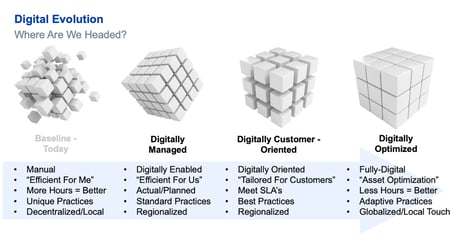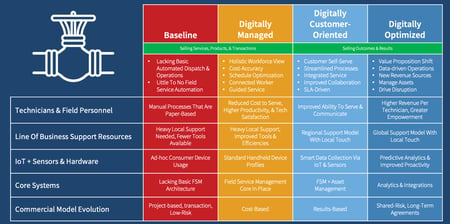Enterprise digital transformation is challenging, especially for companies who do not envision and develop digital products as part of their core value proposition. Let's explore some of these challenges as well as practical solutions.
Quick Summary:
Determine digital investment priorities through benchmarking to unify opinions
Gather early feedback directly from primary digital stakeholders to assess adoption risk
Digitize core internal processes first, then move outward to customers
Communicate digital strategy on a single sheet of paper for focus

Digital transformation has been a top-of-mind strategy for many enterprises seeking to gain competitive advantage. In 2019 alone, enterprises spent an estimated $2 trillion on digital efforts. In addition, a new 2021 IDC study reveals that 65% of global GDP will be digitized by 2022 and will drive $6.8 trillion of direct digital investments through 2023. Further, the intersection of an already pervasive position for digital transformation and the COVID-19 pandemic has intensified the velocity of digital efforts. A recent study by McKinsey and Co. revealed that across the globe, customer interactions are consistently and increasingly moving to a digital context:

While digital transformation is becoming more pervasive, our experience has been that most organizations appreciate the importance of a strong digital strategy, but many face the challenge of understanding how to apply digital maturity in a targeted fashion. In particular, digital strategy is especially difficult for any company that doesn’t itself envision and deliver digital products. These organizations find it difficult to:
- Identify specific areas of digital focus
- Quantify concrete benefits to expect from digital investments
- Organize digital efforts and work in a cohesive manner
In truth, there are many challenging aspects of digital transformation that include applying an effective governance model, establishing a digital architecture, choosing a mode of digital delivery, selecting specific digital technologies as well as the change leadership necessary to ensure success. My focus in this discussion will be on the application of an early guiding digital strategy for focus, unity, and clarity. Also, I'm going to focus this discussion not on achieving a specific digital solution, but on the challenge of targeting and realizing truly holistic enterprise digital maturity across an organization.
One of our valued T4 customers is a recognized leader in industrial inspections. They deploy a very large and highly skilled workforce that performs a complex set of diverse services designed to optimize industrial asset performance for customers. Our original task was to help them operationalize a portfolio of project efforts designed to realize digital maturity. One of the exciting aspects of this effort was the fact that nearly everyone, including senior executive leadership, perceived the opportunity to be huge – the workforce had been working with a primarily manual process that relied heavily on paper and very little standardization of methods. We all felt this to be an opportunity-rich program of tangible transformation with benefits that were evident to all stakeholders.
What we quickly discovered was that, like many enterprises, there were lots of ideas and opinions about what tactics to adopt, but less understanding of or agreement on how to apply a unifying digital strategy to align and guide a portfolio of work.
With so many possible areas of focus, we needed to define a clear call to action that would point the way toward priority of investment. We needed to prove that along with everyone’s strong opinion that digital investment would bring benefits, we had line of sight to real benefits. One of the first things we did was collaborate with multiple internal stakeholder groups to benchmark and define possible returns from investment in digital maturity that focused on both internal and commercial results. This was our “menu” of possible places to focus and expect returns:

Given our experience that adoption of enterprise change of any kind is difficult, we also gathered feedback from the workforce on the potential for digital maturity and any apparent roadblocks or barriers. If our workforce was resistant to a more digital way of working, we’d need to assume a slower and more challenging realization of benefits:

What we found was encouraging – in addition to a clear wealth of provable opportunities for tangible returns from digital investment, we learned that the workforce – who would bear the brunt of adoption challenges – were quite open to a more digital experience and to participating in our group of early Digital Pilot users. Our client’s CIO explained, “This analysis allowed us to put to bed many of the frequently-offered excuses to avoid the changes required to move to digital,”
“This analysis allowed us to put to bed many of the frequently-offered excuses to avoid the changes required to move to digital”
The next challenge was to define how we would organize a broad program of digital change that would be used to chart a course of efforts. To do this, we applied a framework for digital maturity that starts with a largely manual baseline (how digital are we today?) and progresses from the inside-out of the organization. This priority of focus begins with targeted internal improvements and maturity that are intended to ultimately extend outward to customers over time:

This “inside-out” progression also allowed us to break a multi-year effort into smaller, more specific phases of work – each with their own application of governance, project planning, change leadership, and associated milestones.
Finally, because we were able to identify broader themes and a logical sequence, we were able to add specific context to each one to help communicate our intention for digital maturity with a single graphic to a broad group of stakeholders:

“There were eye-openers in the strategy, but the most powerful thing was being able to see a sequence of coordinated moves to increase digital maturity across many roles in the company, and how they would support a cohesive strategy.”
Our client’s CIO remarked, “There were eye-openers in the strategy, but the most powerful thing was being able to see a sequence of coordinated moves to increase digital maturity across many roles in the company, and how they would support a cohesive strategy.” Once we were able to plot the elements of digital strategy in a single sheet of paper, what become apparent was the real opportunity for this customer – to change the nature of their commercial value proposition from transactional selling of short-term individual jobs to the long-term assurance of outcomes and results. This shift had the potential to serve as an industry disruptor.
Based on this clarity, we were able to define a governance structure, a digital reference architecture, select individual technologies, and drive other outcomes. There is certainly more this story, but hopefully this discussion conveys some simple techniques we can apply to help your organization envision and realize the right digital maturity for competitive advantage that connects high-level vision to specific tactics.
I'd love to hear your opinions and learn about your experiences with enterprise digital transformation. Write me at mike.rosenbaum@trans4mative.com

